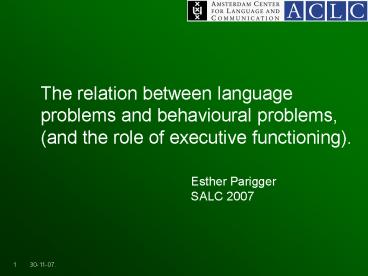1 301107. - PowerPoint PPT Presentation
1 / 27
Title:
1 301107.
Description:
The relation between language problems and behavioural problems, ... Pascual-Leone, 1970, 1987. M- capacity. Interruption (inhibition) Recentration (updating) ... – PowerPoint PPT presentation
Number of Views:246
Avg rating:3.0/5.0
Title: 1 301107.
1
The relation between language
problems and behavioural problems, (and the
role of executive functioning).
Esther Parigger SALC 2007
2
Overview
- SLI and ADHD focus on overlapping symptoms
- Executive functions in SLI with(out) ADHD
symptoms - Semantics/pragmatics in SLI with(out) ADHD
symptoms - ?also compared to normally developing children
- Conclusion and discussion
3
SLI
- Stark and Tallal, 1981
- Bishop, 1994
Impaired hearing Emotional and behavioral
problems PIQ lt 85 Neurological deficits/
lesions Speech motor skill deficiencies Low
reading age
- Diagnosis
- ?Exclusion
- ?Severity
LA Receptive lt MAP/CA (6 mo.) LA Expressive lt
MAP/CA (12 mo.) LA Overall lt MAP/CA (6 mo.)
Diagnosed on the basis of exclusion!
No behavioral problems allowed!
4
ADHD
- APA, 2000
Language items are included in the symptom list!
Diagnosed on the basis of clinical evaluation!
- Diagnosis
- ?Symptoms (division in subtypes)
- -present before 7 years of age
- -present in 2 or more settings
- -significant impairment in functioning
- -not accounted for by another disorder
Symptoms of inattention Symptoms of
hyperactivity/impulsivity
Predominantly inattentive subtype Predominantly
hyperactive/impulsive subtype Combined subtype
5
SLI and behavioural problems
- Botting, 2006 (poster)
- 23 of 200 children with (S)LI
- scored in the atypical range of
- the ADHD scale of the SDQ
- These children performed worse
- in expressive language tasks with
- semantic content
- ? underlying problems with inhibition?
Expected2-6!
6
ADHD and language problems
Parigger and Baker, 2005 Parigger, in prep. (a)
- Subtle problems in language comprehension
- More robust problems in language production
- ? mainly pragmatics
- E.g. percentage of worded plot elements in
Frog-stories - -effect of diagnosis ADHDltTD
- -effect of age 7lt8lt9
7
Possible explanation
Tannock and Schachar, 1996 147
- Executive Dysfunction Theory
- We theorize that the core behavioural
symptoms of ADHD () and the pragmatic
difficulties that these children exhibit ()
are related to deficits in executive function
(i.e. higher-order cognitive processes).
8
This study
Parigger, in prep (b)
- Is it possible, within a SLI group, to
distinguish a group of children with ADHD
symptoms and a group of children without ADHD
symptoms? - If so, is it possible to differentiate these
groups with respect to - 1 Executive functions?
- 2 Semantics/pragmatics?
9
Subjects
- 16 children diagnosed with SLI
- ?14 boys, 2 girls
- ?mean age 82
- ?mean non verbal IQ 91
- 16 normally developing children
- ?12 boys, 4 girls
- ?mean age 82
- ?mean non verbal IQ 115
10
Groups
Oosterlaan et al., 2000
- Dutch checklist for behavioural problems VvGK
- 31 of 16 children with SLI
- scored in the (sub)clinical range of
- the inattention and/or hyperactivity
- scales of the VvGK
Expected2-6!
11
Measures of executive functioning
- CANTAB
- ?Stop Signal Task (SST)
- ?Rapid Visual Information Processing (RVP)
- ?Spatial Working Memory (SWM)
- ?Intra-Extra Dimensional Set Shift (IED)
12
1a Inhibition
- CANTAB Stop Signal Task
- SLIADHD SLI-ADHD
- ? SLI Total Controls Total
13
1b Attention
- CANTAB Rapid Visual
- Information Processing
- SLIADHD SLI-ADHD
- ? SLI Total Controls Total
14
1c Working Memory
- CANTAB Spatial
- Working Memory
- SLIADHD SLI-ADHD
- ? SLI Total Controls Total
15
1d Shifting
- CANTAB Intra-Extra
- Dimensional Set Shifting
- SLIADHD SLI-ADHD
- ? SLI Total Controls Total
16
Summary executive functions
- SLIADHD?SLI-ADHD and SLI Total?Controls Total
- ?most differences in expected direction
- ?differences not significant
17
Measures of semantics / pragmatics
Geurts, 2007
- Translation of Childrens Communication Checklist
2 - ?Semantics Subscale (SEM)
- ?Coherence Subscale (COH)
- ?Pragmatic Composite (PC)
18
2a Semantics Subscale (CCC-2-NL)
- SLIADHD SLI-ADHD
- ? SLI Total gt Controls Total
Example Confuses words of similar meaning, might
say screw-driver for hammer.
19
2b Coherence Subscale (CCC-2-NL)
- SLIADHD gt SLI-ADHD
- ? SLI Total gt Controls Total
Example Uses terms like he or it without
making clear what he the child is talking
about.
20
2c Pragmatic Composite (CCC-2-NL)
- SLIADHD gt SLI-ADHD
- ? SLI Total gt Controls Total
This composite score consists of the subscales
inappropriate initiation, stereotyped
language, use of context and nonverbal
communication.
21
Summary semantics/ pragmatics
- SLIADHD?SLI-ADHD
- ?differences in expected direction
- ?most differences significant
- ?differentiation on coherence subscale and
pragmatic composite - SLI Total?Controls Total
- ?differences in expected direction
- ?differences significant
22
Conclusion
- It is possible, within a SLI group, to
distinguish a group of children with ADHD
symptoms and a group of children without ADHD
symptoms. - These groups differ with respect to their scores
on the coherence subscale and the pragmatic
composite. Unexpectedly, they dont differ with
respect to executive functioning.
23
Further research
Parigger, in prep (c)
- Main study
- Comparison of language profiles and cognitive
profiles of children with ADHD, children with
SLI, and normally developing children
24
Information
- E e.m.parigger_at_uva.nl
- W http//home.medewerker.uva.nl/e.m.parigger
- T 0031-20-5253811
Ill upload a hand-out!
25
Extra Theory of constructive operators
(TCO)
- Im-Bolter, 2006
- Pascual-Leone, 1970, 1987
M- capacity
Recentration (updating)
Language competence
Interruption (inhibition)
Decentration (shifting)
26
Extra2d General Communication Composite
(CCC-2-NL)
- SLIADHD gt SLI-ADHD
- ? SLI Total gt Controls Total
27
ExtraDiscussion
- Correlations
- VvGK-score on attention and hyperactivity
- with semantic subscale r,496
- with coherence subscale r,501
- with pragmatic composite r,618































